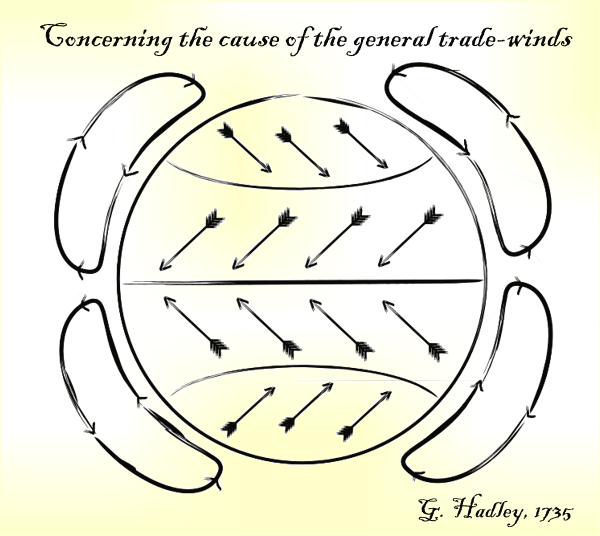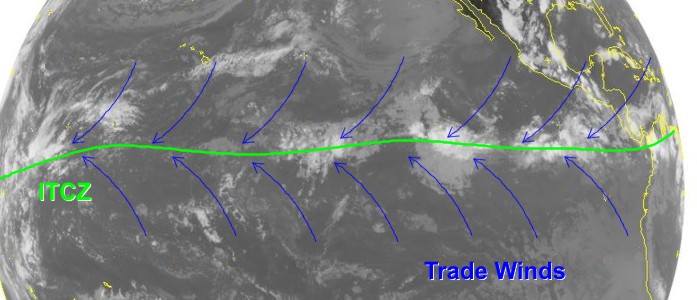Prioritize...
After completing this section, you should be able to define Earth's "general circulation," and be able to discuss the Hadley circulation in the tropics, specifically the Intertropical Convergence Zone (ITCZ) and the hot towers that form along it.
Read...
Astronomer Edmond Halley loved to dabble in various scientific fields of study. In 1705, he calculated that a bright comet he observed in the heavens was periodic and that it would return in 1758. His computations were correct, although Halley didn't live long enough to see his prediction come true. In deference to his achievement, the comet now goes by the name Comet Halley. Besides astronomy, Halley also was into tides, cartography, naval navigation, and, yes, tropical meteorology. Halley actually offered the first detailed explanation of the trade winds, which were first discovered by Christopher Columbus on his voyage to the New World. These reliable winds were so crucial to commercial sailing ships that the name "trades" developed. Ever inquisitive, Halley aspired to formulating a complete scientific theory that explained the trades.

In 1735, George Hadley supported Halley's theory that strong solar heating over equatorial regions incited rising currents of air that eventually hit a ceiling of sorts (the tropopause) and then spread poleward, culminating in sinking air over latitudes much farther away from the equator. Envisioning a closed circuit of air (see the schematic on the right). Hadley saw the trade winds as the return (equator-ward) flow of air at low levels.
According to Hadley, these closed circuits (one in each hemisphere), which would eventually be called Hadley Cells in his honor, were part of his model of the earth's general circulation. What exactly is the Earth's general circulation? Suppose that winds at a given location are averaged over time periods longer than the longest-lived weather system (a season, for example). Often, a preferred speed and direction emerge. The global distribution of these "preferred winds" at a variety of altitudes constitutes the general circulation.
Hadley's model was somewhat oversimplified (especially at middle and high latitudes), but he had the right idea about the general circulation in the tropics. Indeed, the strongest signal in the earth's general circulation comes from the tropics, where the persistent Hadley Cells govern the monotonously persistent weather at low latitudes.
There are pronounced seasonal changes in the tropics, but these changes are not as closely linked to the sun angle as they are over the middle and high latitudes. Indeed, seasonal variations in temperature, which are usually small by mid-latitude standards, are somewhat out of step with the "solar calendar". Instead, they are often in step with seasonal shifts in wind direction or trends in precipitation. These seasonal shifts are largely governed by the location of the Intertropical Convergence Zone (ITCZ), which is the region where the opposing trade winds in each hemisphere converge. The annotations on the infrared satellite image below show idealized trade winds converging along the ITCZ.

Note in the image above that tall, cumulonimbus clouds mark clusters of showers and thunderstorms along the ITCZ. Indeed, the ITCZ is typically marked by a broken chain of showers and thunderstorms that rings the globe as converging trade winds give warm, moist air parcels a nudge upward to initiate convection. Air rises in these so-called "hot towers" all the way up to the tropopause (which is at a higher altitude in the tropics than it is at higher latitudes) and spreads poleward, eventually sinking near 30 degrees North and 30 degrees South latitude. Some of that air then flows back toward the equator at the surface, forming the trade winds and completing the closed circuit of the Hadley Cells.
That's just a quick look at the basics of Hadley Cells in the tropics, but there are more details to explore. For example, the convergence in the ITCZ doesn't universally occur along the equator (the location of the ITCZ meanders throughout the year). Why is that? We'll find out as we explore the ascending branch of the Hadley Cell coming up next!